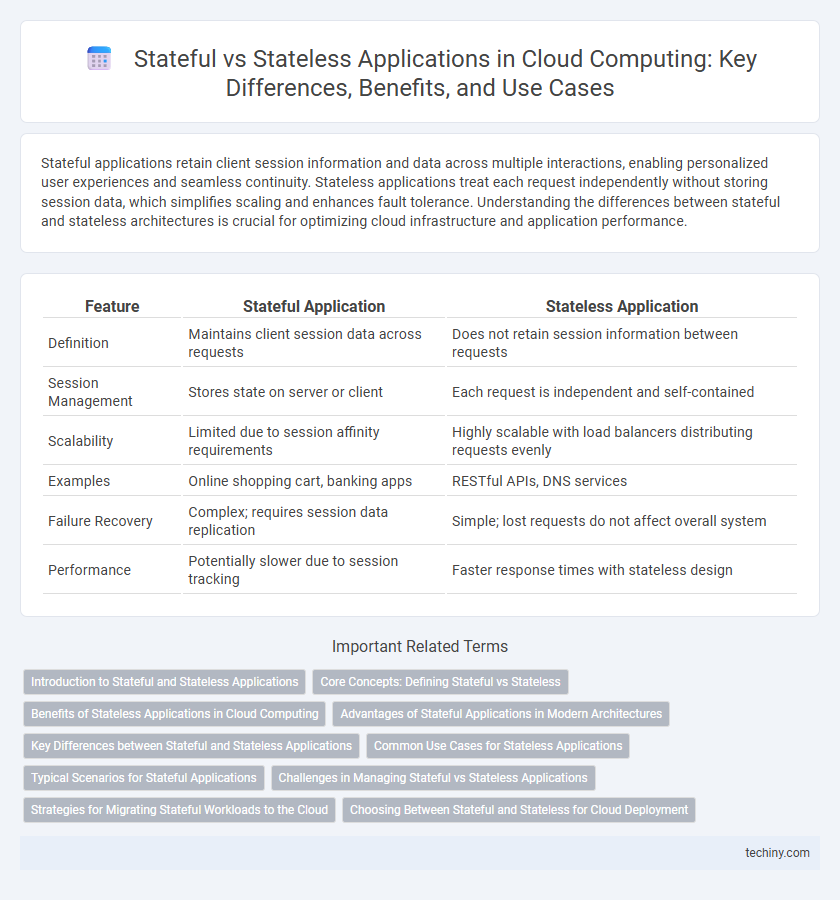Stateful applications retain client session information and data across multiple interactions, enabling personalized user experiences and seamless continuity. Stateless applications treat each request independently without storing session data, which simplifies scaling and enhances fault tolerance. Understanding the differences between stateful and stateless architectures is crucial for optimizing cloud infrastructure and application performance.
Table of Comparison
| Feature | Stateful Application | Stateless Application |
|---|---|---|
| Definition | Maintains client session data across requests | Does not retain session information between requests |
| Session Management | Stores state on server or client | Each request is independent and self-contained |
| Scalability | Limited due to session affinity requirements | Highly scalable with load balancers distributing requests evenly |
| Examples | Online shopping cart, banking apps | RESTful APIs, DNS services |
| Failure Recovery | Complex; requires session data replication | Simple; lost requests do not affect overall system |
| Performance | Potentially slower due to session tracking | Faster response times with stateless design |
Introduction to Stateful and Stateless Applications
Stateful applications maintain client session information and track user interactions across multiple requests, enabling personalized and continuous user experiences. Stateless applications treat each request independently without retaining any previous session data, resulting in improved scalability and simplified server design. Understanding the differences between stateful and stateless architectures is crucial for optimizing cloud infrastructure, load balancing, and application deployment strategies.
Core Concepts: Defining Stateful vs Stateless
Stateful applications maintain client session information and data across multiple requests, enabling personalized user experiences and complex transaction processing. Stateless applications treat each request independently without storing session data, enhancing scalability and simplifying load balancing. Understanding the core difference between stateful and stateless architectures is fundamental for designing cloud-native systems that optimize performance and resource management.
Benefits of Stateless Applications in Cloud Computing
Stateless applications in cloud computing enhance scalability by enabling easy replication and load balancing across multiple servers without requiring session data synchronization. They reduce infrastructure complexity and improve fault tolerance since each request is independent, minimizing downtime and simplifying recovery processes. This architecture also supports rapid deployment and continuous integration practices, accelerating development cycles and operational efficiency.
Advantages of Stateful Applications in Modern Architectures
Stateful applications maintain client session data across multiple interactions, enhancing user experience by preserving context and reducing repeated authentication or data fetching. This persistence enables efficient handling of complex transactions and real-time collaboration in modern cloud architectures. Additionally, stateful designs simplify the management of user-specific data, improving system responsiveness and reliability in distributed environments.
Key Differences between Stateful and Stateless Applications
Stateful applications maintain client data and session information across multiple requests, enabling continuous interactions and personalized user experiences, while stateless applications treat each request as an independent transaction without retaining any session state. The key difference lies in state management: stateful apps require persistent storage or databases to track session details, whereas stateless apps rely on external systems or repeat client data with each request to achieve scalability and fault tolerance. This fundamental distinction impacts application design, scalability strategies, and cloud resource optimization in distributed environments.
Common Use Cases for Stateless Applications
Stateless applications are commonly used in web servers, APIs, and microservices where each request is independent, enabling easy scaling and fault tolerance. They facilitate load balancing and horizontal scaling in cloud environments by not relying on stored session data. Popular use cases include content delivery networks, serverless computing, and real-time data processing where rapid, scalable responses are critical.
Typical Scenarios for Stateful Applications
Stateful applications are commonly used in scenarios requiring continuous session data retention, such as online banking platforms where transaction history must be preserved to ensure accuracy and security. These applications are critical in real-time multiplayer gaming environments that maintain player states and game progress to deliver seamless user experiences. Stateful designs also support e-commerce systems managing shopping carts and user preferences, enabling personalized interactions and improved customer engagement.
Challenges in Managing Stateful vs Stateless Applications
Managing stateful applications involves complex challenges such as maintaining session data consistency, ensuring data persistence, and handling failover without data loss. Stateless applications simplify scaling and recovery by treating each request independently, but they require efficient mechanisms to externalize state, often increasing architectural complexity. The trade-offs in managing state consistency, resource allocation, and fault tolerance highlight the operational challenges between stateful and stateless cloud-native applications.
Strategies for Migrating Stateful Workloads to the Cloud
Migrating stateful workloads to the cloud requires strategies such as data synchronization, containerization with persistent storage, and implementing distributed databases to maintain session continuity. Leveraging cloud-native services like Amazon RDS or Azure Cosmos DB helps manage state data efficiently while ensuring high availability and fault tolerance. Adopting microservices architecture further decouples state management, enabling smoother scaling and migration.
Choosing Between Stateful and Stateless for Cloud Deployment
Choosing between stateful and stateless applications for cloud deployment depends on workload requirements and scalability needs. Stateful applications maintain session information and are ideal for use cases requiring persistent data, such as databases and user sessions. Stateless applications enhance scalability and fault tolerance by processing each request independently, making them suitable for microservices and serverless architectures.
Stateful Application vs Stateless Application Infographic

 techiny.com
techiny.com